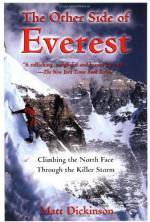|
This section contains 4,585 words (approx. 16 pages at 300 words per page) |

|
The high camps on Everest are in a region known as the Death Zone, which is any part of Everest above 24,606 feet. The term was first used by Swiss physician Edouard Wyss-Durant, who, in his 1952 book The Mountain World, first identified the symptoms of altitude sickness. After careful study he determined that no one could survive for very long once he or she passed the 24,606-foot mark.
Living in the Death Zone can be extremely dangerous and exhausting. Campsites are bleak, and the altitude makes many people feel sick and depressed. Consequently, after spending time in this region, many mountaineers find themselves wondering why they ever decided to come to Everest at all. Matt Dickinson reflects the common sentiment when he describes the north Camp V, at 25,196 feet:
The platform [where I pitched my tent] was littered with the shredded remains of...
|
This section contains 4,585 words (approx. 16 pages at 300 words per page) |

|




